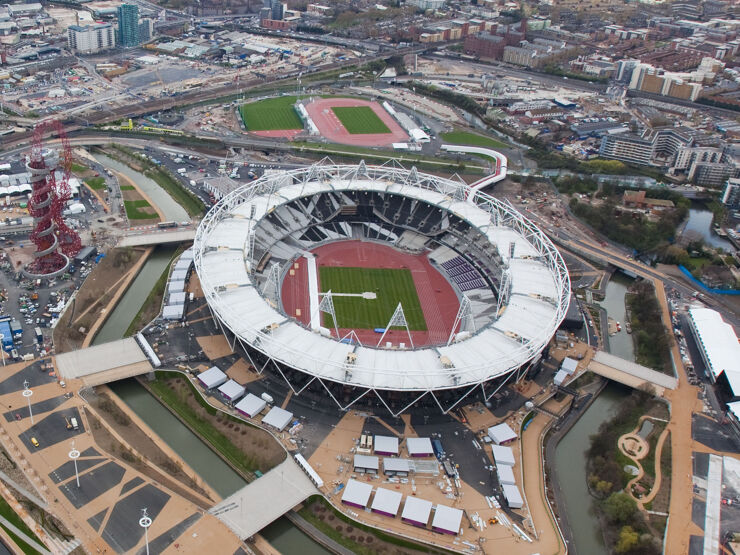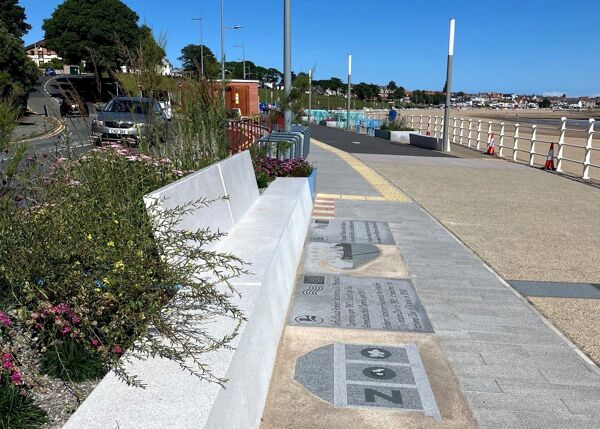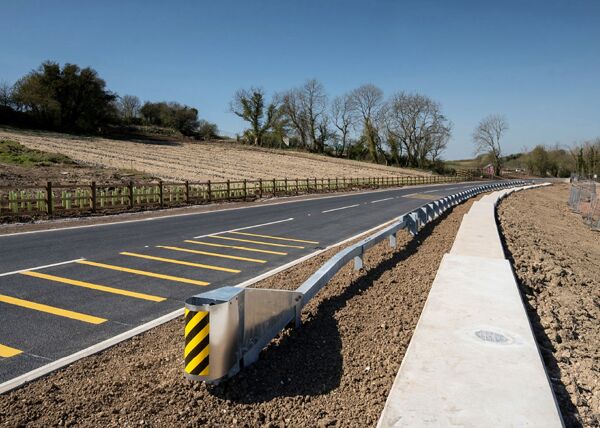
NEC was used by the UK Olympic Delivery Authority (ODA) to deliver the construction programme for the venues and infrastructure required to host the London 2012 Olympic and Paralympic Games. The programme was delivered within budget and ahead of schedule, all against a backdrop of an increasingly tough economic climate and intense public scrutiny.
Embedding the Spirit of NEC
In 2006, ODA made an early decision to employ the NEC3 suite of contracts across the majority of its projects, and sought to embed the spirit of NEC throughout ODA and its delivery partner, CLM, a joint venture between CH2M Hill, Laing O’Rourke, and Mace. The flexibility and approach to change control that NEC3 contracts offer has helped to make possible what has been a truly unique collaboration between public and private sectors in the UK. It has helped enable delivery through a contractual framework embodying transparency and governance.
Its selection centred on the right mix of key facets that would enable ODA to deliver its obligations successfully, including:
- A wide adoption in the marketplace, with a proven track record of use in the supply chain
- An extensive array of standard commercial and contractual approaches that support different project types
- An ethos of collaboration
- A robust change-control mechanism that offers transparency over the cost and schedule impacts of each change event
- The transparent management of risk
Over 100 NEC3 Contracts used
To facilitate the assets required on the Olympic Park for the games, over 100 NEC3 contracts have been managed and integrated, involving a critical supply base of over 850 suppliers, generating in the region of 50 000 key contract communications with an overall average monthly spend of £140 million.
An NEC3 Professional Services Contract was agreed with CLM to provide programme and project management services to ODA. The contract saw CLM accept significant delivery risk, and ODA incorporated programme-level cost and schedule incentives linked to the phases of delivery.
A mix of NEC3 Engineering and Construction Contract (ECC) Options A (priced contract with activity schedule), C (target contract with activity schedule), E (cost reimbursable contract) and F (management contract) were used for various parts of the construction. You can read about specific parts of the build such as the Copper Box and parks and waterways in the newsletter linked below, and the Velodrome on the NEC website.
Fit for purpose
ODA and CLM moved to finalise the delivery structure for the major projects, adopting a model based around a main contractor approach, with an integrated project team consisting of ODA, CLM and contractor. Through this model ODA sought to engender an ethos of collaboration from the beginning.
As part of the process, ODA and CLM refined a proforma works and site information document, combining the two into the ‘project information’. This was split into site-wide and project-specific sections, which could be utilised on each contract, maximising efficiency.
The method of producing the works and site information has been very well received by the supply chain and has provided significant benefits to the project management team.
Moving into the market
The delivery structure informed the detail of the major procurement programme, which began with a wide market engagement exercise.
In 2007, the UK construction market was buoyant, and the ongoing issues with the Wembley Stadium redevelopment were fresh in the minds of the likely supply chain. With numerous private enterprise clients offering projects that were lower risk and of considerably lower profile than London 2012, initial market testing demonstrated little appetite for work on the programme.
A regime of events targeted at stimulating both appetite awareness of the project resulted largely in success. However, the first two venues to be procured – the main Olympic Stadium and the Aquatics Centre – both still suffered from a lack of widespread interest, predominantly because these were the first venues ‘out of the blocks’, and ODA was still an unproven entity.
In recognition of both the likelihood of changes to the Olympic Park, and the then-buoyant economic climate, the early venue contracts – including the Velodrome and the Media Centre – were let on an NEC3 ECC Option C basis, with the contractor’s share positioned to ensure an equitable risk-sharing position.
Changing with the market
As part of ODA’s commitment to a sustainable games, a number of venues were designed to be temporary, and will be removed and reused (either in whole or in part) after the games. The principal temporary venues are:
- Basketball Arena
- Water Polo Arena
- Eton Manor (although Eton Manor Sports Complex is a permanent structure and will provide legacy recreational facilities)
The original delivery model for temporary venues had been the same main tier 1 contract model employed for the major permanent assets. However, in response to the then buoyant market conditions, and utilising the specific experience of the delivery partner, ODA and CLM developed an alternative model for temporary venues, the ‘managed package solution’ (MPS) approach.
The MPS strategy falls somewhere between a traditional design-and-build contract, and a construction management approach. Under this model, ODA contracts for specific trade packages of work for a particular venue, with CLM managing multiple contracts per venue.
NEC3 framework agreements
To support the MPS approach, a number of framework agreements were procured, as follows:
- General builder
- Civil engineering
- Building services
- Lightweight event structures
- Modular accommodation
- Seating
- Design services
The frameworks were procured on the basis of the NEC3 Framework Contract, incorporating Options A, C and E of the ECC, and the PSC in the case of design services. The frameworks were then used to procure the individual packages for the temporary venues.
The MPS frameworks and overall approach provided ODA with an alternative, ‘plan B’ option in the face of market issues, and more importantly afforded ODA a unique structure that enabled it to access efficiently the breadth of the UK supply chain, in full compliance with relevant regulation.
| London 2012 Procurement in Numbers | |
|---|---|
| 1 | Programme |
| 55 | Major projects |
| 96 | Tier 1 suppliers |
| 100+ | Contracts |
| 890 | Critical tier 2 and 3 suppliers |
| 1,400 | Unique principal contractor boundaries |
| 151 | Stakeholder delivery milestones |
| 27,000 | Integrated plan activities |
| 1,520 | Integrated plan linked activities |
| 50,000 | NEC3 early warning notices and compensation events |
| 7.3 | Budget in £ billions |
| 1 | Key date, 27 July 2012 |
Moving to the finish line
As the programme progressed, and the financial crisis began to take hold, ODA was well positioned to benefit. The target contracts for the main venues allowed it to see the benefits of reduced costs in the supply chain result in reduced defined cost to its tier 1 contractors.
In tandem, the temporary venues were just entering procurement, along with the Copper Box handball venue, and the constricting market resulted in greater competition and a greater risk appetite in the supply chain. Ultimately all of these contracts were let on the basis of ECC Option A.
The combination of a genuine ethos of cooperation across the programme, and the use of innovative incentive with strong commercial leadership, has seen ODA’s constructed assets completed on or before schedule, with most completed a year before the games themselves, and significantly under budget.
Benefits of using NEC
Kenneth Owen, Commercial Director of CLM, said "It is right to say the NEC3 suite of contracts has been one of the central key enablers whereby such performance has resulted in over £600 million of public money being saved without missing one key schedule completion and handover date".
He continued "The London 2012 programme has demonstrated that NEC is more than just its various contracts – it should be regarded as a methodology and philosophy for good project and programme management. At the end of the day, the ultimate barometer of success is the functional asset delivered when required, at an affordable price for the client and with fair reward for the supply chain. There should be no delays, disputes or adjudications, which have an ultimate adverse impact to clients’ and suppliers’ businesses and reputations. On that basis, NEC is every bit a success".
Reporting on the success of the Olympic Park construction works, Built in Britain presenter Evan Davis said on BBC2 in October 2012, "behind the scenes there was a secret to that success ...the hero of the games, the hero of the Park, was the NEC". He asked Olympic Delivery Authority chairman John Armitt if the project would have been delivered as successfully if he had used a different contract form. Armitt replied, "No, I don’t think it would, you couldn’t do it".
Further Reading
Looking for more details? Read the special issue NEC newsletter from April 2012 for more facts, figures and insights.




